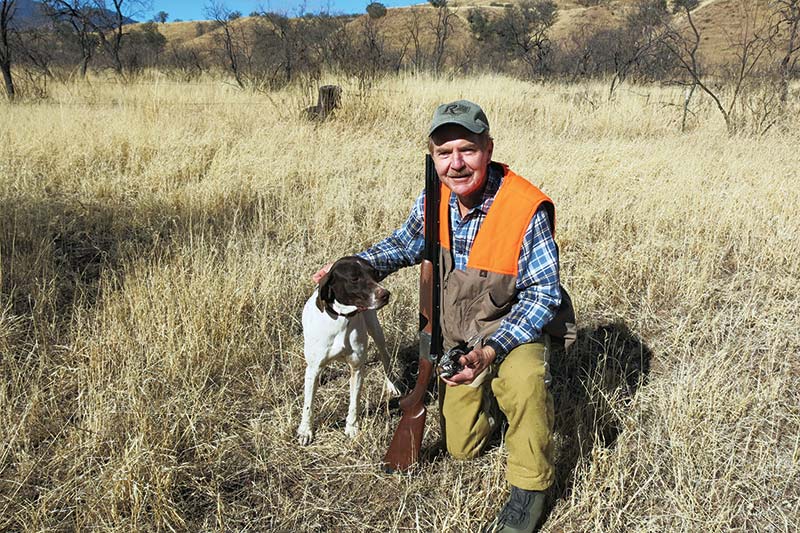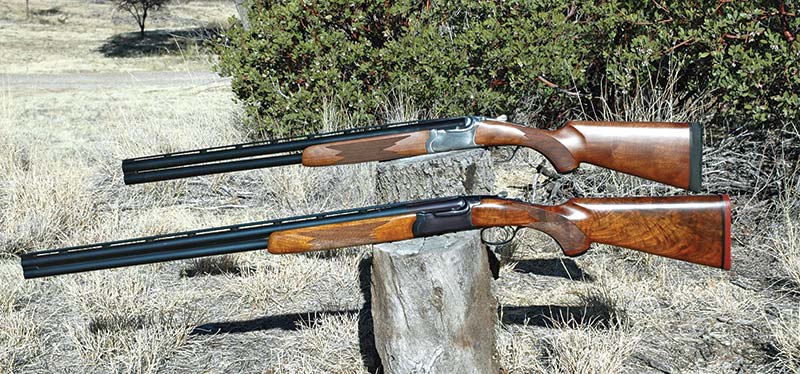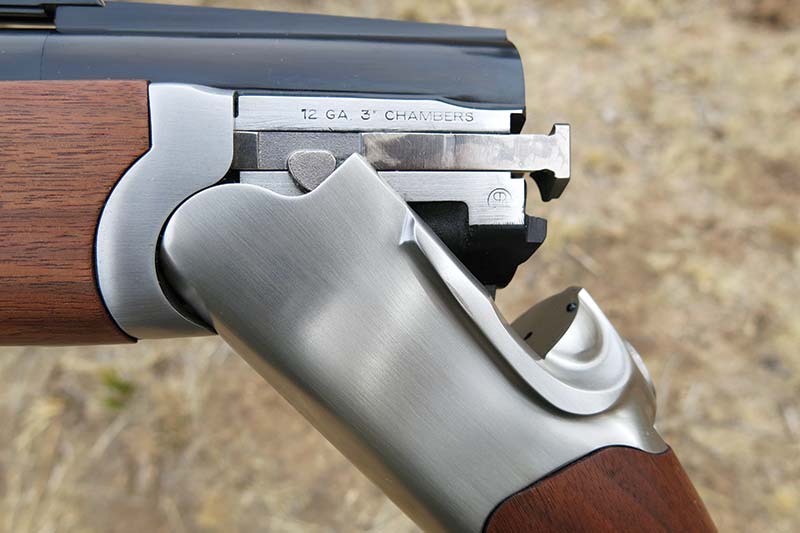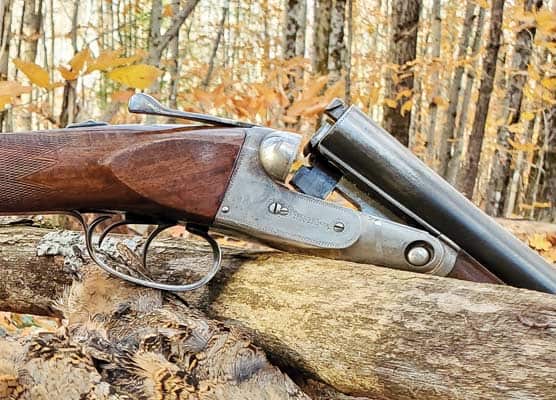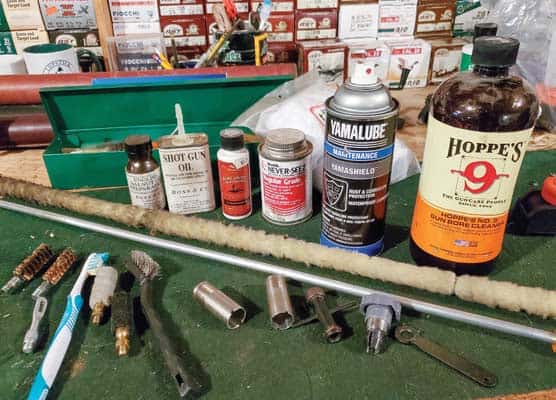The Return Of The Red Label
Ruger’s New Redesigned Over/Under 1
2-Gauge Shotgun Is A Game Getter
In a brief note in the 1973 Annual Report, Bill Ruger, Sr. reported work had begun on an O/U shotgun and a limited number would be available for sale in 1974. The report was a bit optimistic, and for the next four years, rumors flew around the shooting world as to what the new O/U would look like and what its price might be. In 1977, we got our first look. Spread across the cover of the 1978 Gun Digest were three images of a slim, trim, Ruger Red Label, engraved with gold inlays by Alvin White with a serial number of 81.
It was a marketing ploy Ruger and his close, tweedy friend and editor, John T. Amber, would play on the shooting public a number of times. Picture the first public view of a new Ruger model on the cover of Gun Digest, but report, “We don’t have any further details,” thus whetting the shooting public’s appetite until it was roaring at a fever pitch when the actual product release occurred, which typically was a year or more later.
By 1978, a few Red Labels had begun to dribble out. We were caught by surprise. In a country dominated by the 12-gauge, the initial field-grade Red Label was a 20-gauge. In many respects, it was very European. The low-profile frame was thin-walled and shallow. The standing breech was nicely sculptured. The 26- or 28-inch barrels rode on high-mounted, bifurcated lumps rather than a hinge pin. Locking bolts on each side of the standing breech engaged matching lugs placed at 3 and 9 o’clock positions at the lower barrel. Ejectors were automatic. The chokes were fixed and bored IC/IM, F/M or S/S. The sliding tang safety was also the barrel selector, and the single trigger was mechanical, not requiring recoil for a reset.
The quality of the walnut used in the early years of production was outstanding with excellent figure and color, but the butt was finished off with an unyielding, hard, red, rubber pad. Checkering was hand-cut and crisp. The free-floating, ventilated rib was functional, and the side ribs between the barrels could be unscrewed to increase airflow between the upper and lower barrels.
The price? Hold your hats! Four hundred eighty bucks — of course those were long gone, 1978 dollars. At the same time, the Beretta S55B was priced at $545; the Browning Citori at $462; the Remington 3200 at $750; the SKB at $480 and the Winchester 101 at $580. It was a competitive O/U field, but the Ruger name carries with it definite panache and a faithful following. Shooters who already owned Ruger pistols and revolvers, bolt-action and single-shot rifles and the ubiquitous 10/22’s were drawn to Ruger’s American-made shotgun like flies to honey.
To understand the gun, you had to understand Bill Ruger, Sr.’s concept of producing high-quality and affordable guns by modern production processes. He observed, “Provided good looks, strong components and sensible design features are employed, there is always room to make a few guns profitably. I felt that Americans deserved a good over-and-under shotgun made by Americans… We put the money into machinery rather than hand labor… Perhaps you could say that, except for engraving, gold inlaying and elegant finish, using machines you can easily surpass the work of the finest person in terms of true mechanical movement, the precision of the apparatus. You have to remember—fine watches are not made by files.”
Over the next 32 years of production, the Red Label was offered in a variety of styles and gauges. The 12-gauge was introduced in 1980 and a 28-gauge in 1985. A stainless steel receiver in 12-gauge was added to the line in 1985. Introduced in 1988, screw-in chokes became standard on all models in 1991. A straight, English-style grip was offered as an option in 1992 as the “English Field” model. There were field grades, sporting clays models, engraved models and even an elegant “Woodside” model featuring walnut sideplates. In 1995, all models were given Ruger’s “EZ-opening” action with rebounding hammers.
In 2011, the Red Label models, then selling for approximately $1,956, was returned to the drawing board to be redesigned for better handling and modern production methods. Bill Ruger Sr.’s comments in the 1978 Annual Report proved prophetic: “As it happened, our profits have not been significant, but we are now rethinking the entire manufacturing concept of the Red Label, and hope to better the profit picture without changing the gun.”
Bill Sr.’s comment was echoed in 2013 by Ruger President and CEO, Mike Fifer, who observed, “We knew we could employ newer technology, improve the design and deliver a better performing Red Label.” They’ve done it while knocking $550 off the old price. The current retail is $1,399 for the new Red Label.
The “new” Red Label is initially a 12-gauge with a brushed stainless steel receiver. A 20-gauge should be coming out later this year. At first glance, it’s hard to tell it apart from its predecessor. It’s not until you pick it up and swing it and then shoot it, do you begin to feel some of the subtle improvements.
Nothing determines the dynamics more in a stack-barrel field gun than trim barrels and an even balance of weight between the hands. Ruger’s taken some weight out of the barrels and eliminated the detachable side ribs. The result is that the balance point has been moved back approximately 1/2 inch. In spite of a weight of 7-1/2 pounds in the 26-inch barrel model, the new Red Label is a fairly lively and smooth-swinging gun.
Red Labels were never soft in the recoil department, and even my old 20-gauge punches a bit more than it should wearing its rigid, red rubber pad. Ruger addressed felt recoil in the new gun. The barrels are back-bored to the maximum, and the forcing cones have been punched forward to a full 2 inches, which not only helps to moderate recoil but improves patterning as well. Ah, and instead of that red rubber pad, there’s now a soft, 1-inch thick, Pachmayr “Decelerator” pad with a smooth “Speed Mount Heel” insert to eliminate clothing snags as you mount the gun.
Be forewarned though, when resting the gun butt down against a vertical surface, it’s resting on that hard heel insert, and the whole gun will skate out across the floor and crash land the minute you turn your back. My test gun from Ruger came supplied with a pre-crushed ventilated rib, and dollars-to-donuts, that’s how the dinged rib came to be.
The walnut stock is plain-grained and machine checkered. Inletting is okay, although on the test gun the joining of the stock to the rear of the receiver revealed an unnecessary gap or two. Since the test gun was an early production piece, I checked the inletting of several Red Labels on display at the January SHOT Show. The inletting on those guns was much improved, and the gaps gone.
Stock dimensions are average for a flat-shooting field gun. The length-of-pull is 14.5 inches, the drop-at-the-comb, 1.50 inches and drop-at-the-heel, 2.50 inches.
Without tearing the gun apart, it’s impossible to see what changes have been made in the internals to facilitate modern production, but Ruger indicates one of the major improvements is the receiver is now a 1-piece casting ensuring consistency and minimizing handfitting. The former receiver was cast in two parts, machined to mate and then welded together and machined again.
A nice touch to the new Red Label is the packaging. The gun comes cased in a fitted, semi-hard, logo-embossed, zipper-closing case with five, steel-shot-compatible Briley choke tubes (F, M, IC, S & S) a Briley choke-tube wrench, gun lock and owner’s manual. It’s a neat package, and if you have an old Red Label, Ruger is more than happy to sell you the new form-fitted case for your gun.
To see how the Ruger would perform in the field, hunting friend Bud Bristow, two pointers, the Red Label and I headed south from Tucson to Mearns’ quail habitat. The Red Label was fitted with a skeet choke in the lower barrel and an improved cylinder tube in the upper. My load was Winchester’s Super Speed Xtra, which throws 1 ounce of 7-1/2 shot at 1,350 fps. It’s a super load for birds over point, and we all went on to have a fine morning of quail hunting at the end of the season.
For Ruger aficionados, the Red Label’s return to the line will be well received. To existing Red Label owners, you might just take a look at what Ruger has done to upgrade and improve this familiar stalwart’s handling qualities. In the meantime, we can’t wait to see the smaller framed 20- and 28-gauges returned to the line.
Red Label
MAKER: Sturm, Ruger & Co., Inc.
1 Lacey Place
Southport, CT 06890
www.ruger.com
Action Type: O/U
Gauge: 12
Chamber: 3 inch
Choke: Briley Tubes: f, m, ic, s & s
Capacity: 2
Barrel Length: 26 (tested), 28 or 30 inches
Overall Length: 43, 45, 47 inches
Length Of Pull: 14-1/2 inches
Drop At Comb: 1-1/2 inches
Drop At Heel: 2-1/2 inches
Weight: 7.5, 7.7, 7.9 pounds
Finish: Polished stainless steel and blue
Sights: VR with brass bead
Stock: Walnut
Price: $1,399
Further Reading
Ruger & His Guns by R. L. Wilson, Hardcover, 358 pages ©1996, $50, from: A&J Arms Book Sellers, 4731 E. Cooper St., Tucson, AZ 85711. (520) 512-1065, www.ajarmsbooksellers.com
